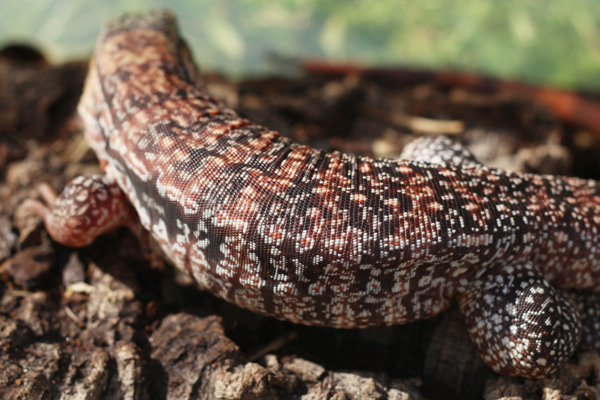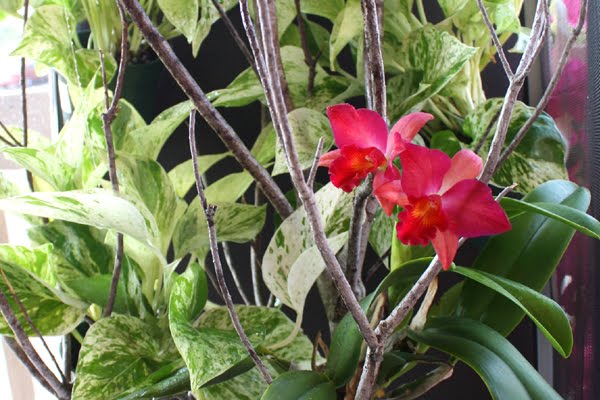Something that people never talk enough about to new keepers is the problem of what to do with all the water you're spraying into your cages. As a new keeper, you read about the importance of providing lots of water, whether it's sprayed or dripped, for how long, how often, whether you should filter or not, etc. But very little is said about what you're supposed to do with all the water that is now pooling on the bottom of your cage and running out over the sides, ruining you nice wood console table and the carpet.
Some people try to cope by laying down towels, paper, or Shamwow rags. This works at first, until you get so tired of changing them out daily that you dread having to mist the chameleon. Others try to set the cage over a storage bin, so the water collects in there. Until you realize that neither you or the chameleon enjoy having you lift the cage off of the bin to dump out every day. So in the end, people end up misting for very short bursts of time or relying more on a dripper (which can drip into a Tupperware container on the floor of the cage.)
Long story short, people get tired of dealing with inefficient ways to deal with the water, they end up dreading or postponing misting their chameleon, or both. In my opinion, the best way around this is to roll up your sleeves, bring out that ol' toolbox, and make something custom to meet your needs. My personal solution was to make drainage tables. I've made several over the years, some better than others, and by now I have the process down to a science. I will go over a few of my designs below.
ATTEMPT #1 - Mediocre but Functional
My first attempt at building a table with completely mediocre, as was everything about my first chameleon set-up, many years ago. This cage belonged to my only chameleon at the time, a water-needy Jackson's chameleon. I didn't even have my automatic misting system back then, and used the shower curtain to contain the spray and to keep humidity up. Also, I didn't have the tools and experience I do now, so the table was very poorly built (and sealed.)
 |
| The cage sat on 4 bricks, and the water ran onto the table and down a hole into a bucket underneath. |
The table had several fatal flaws. For one, I underestimated at the time how much silicone and sealant I should apply to anything coming into contact with this much water. The table was essentially rotten about 4-5 months later. Additionally, because the table had no slant, the water pooled in the corners and made decay happen faster. Do not make the mistakes I made!
Total Cost: ~$30.
Total Cost: ~$30.
ATTEMPT #2 - Much Better!
After the previous colossal failure, my roommate and I sat down and drew out better plans. He was an engineer, so he helped me get the measurements perfect and helped with the cutting of the new wood. This time I wanted two separate tables, where two large screen cages (base measurement of 2' x 2') would sit, side by side. At this time I had four chameleons and four cages.
 |
| Top of one drainage table, with wood bars removed. The entire sheet of shower liner sloped towards the hole in the center, with was very carefully siliconed. |
The table was made taking a solid sheet of wood (over 2' x 4') and nailing on 6 legs. Then 6" wide planks were nailed to the sides, vertically. At this point, we nailed the large PVC shower liner sheet (from Home Depot) to the sides and to the center hole. Then, 2" bars of wood were nailed over the PVC sheet edges, securing the sheet but also making a level. Additional bars of wood were cut to fit exactly the width of the inside of the table to fit on the level, so everything on the table would be flush.
This "grill" of wood bars would form the base upon which the cages would sit. The bars could be moved around depending on where I needed them, and then any water that fell from the cages would fall straight down onto the plastic sheet, where it was funneled out quickly and effectively.
 |
| The bars of wood that form the "grill" of the cage were bundled up in tape here for transportation. But see how they sit on the table. |
 |
| Here you can see how well the plastic was slopped towards the center. Easy to wipe clean, never leaked, never rotted. |
This set of tables lasted me several years, until I wanted to re-do the room in way that looked more professional. At the end of the day, I am not a carpenter and I don't have a proper wood work space, so my tables were never going to be furniture quality. I ended up selling these tables to another local chameleon keeper.
Total Cost: ~$150 for both tables.
Total Cost: ~$150 for both tables.
ATTEMPT #3 - Adapting Pre-Made Storage
This has been my favorite set-up of all time. It didn't look quite as put together as my inspiration photo, but it came close and it allowed me to have a much more professional set-up with lots of storage that didn't look home made.
I went to Lowe's and picked up one large, 2' x 4' x 8' large storage shelf in grey. I comes divided into two parts, so I put them side-by-side instead and got two tables from the one shelving unit. Then I got $1 trays from Walmart and siliconed them onto the top shelf, with a hole through both. This was going to act as the catch tray for the water that fell from the cage's little holes, and would funnel it down and into a bucket. The wood bars would suspend the cages above everything.
I went to Lowe's and picked up one large, 2' x 4' x 8' large storage shelf in grey. I comes divided into two parts, so I put them side-by-side instead and got two tables from the one shelving unit. Then I got $1 trays from Walmart and siliconed them onto the top shelf, with a hole through both. This was going to act as the catch tray for the water that fell from the cage's little holes, and would funnel it down and into a bucket. The wood bars would suspend the cages above everything.
A more thorough tutorial is here:
My Chameleon Room and Cages
My Chameleon Room and Cages
 |
| Setting up the drainage before the cages go on. |
 |
| Every 2 cages had this PVC pipe connection to lead water into a single bucket. And because the PVC was so flush against the bottom of the shelf, it could not be seen by visitors. |
 |
| The finished product (before a little more tweaking was done to clean up the extension cords, etc.) |
 |
| Another photo of the finished product. |
So be creative! Although online stores are starting to make water-collecting trays for screen cages, none of them are created in such a way as to lead the water out and away for easy disposal. Think about what you need from your drainage and figure out how to make it. Any one of these products was not overly expensive, perhaps $100 with all the materials. Well worth it if you can save your floors! (Like in my case, since I rent!)














How does the water pass through the white cage tray
ReplyDeleteI drilled a series of small holes into the center of the acrylic bottom, so water funnels towards the center and then falls through the holes. If you follow the link that I have above called "My Chameleon Room and Cages" it'll take you to the more thorough walk-through of how I made that drainage.
Delete¡Te felicito! Excelente ayuda, gracias. Cuenta conmigo si necesitas ayuda. Saludos.
ReplyDeleteMuchisimas gracias!
Delete